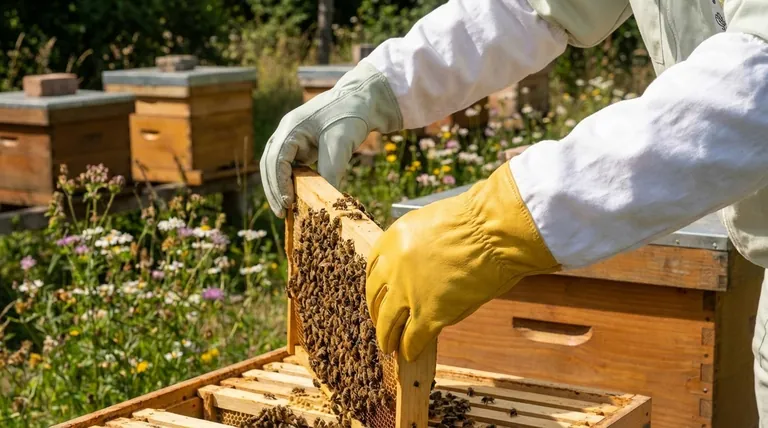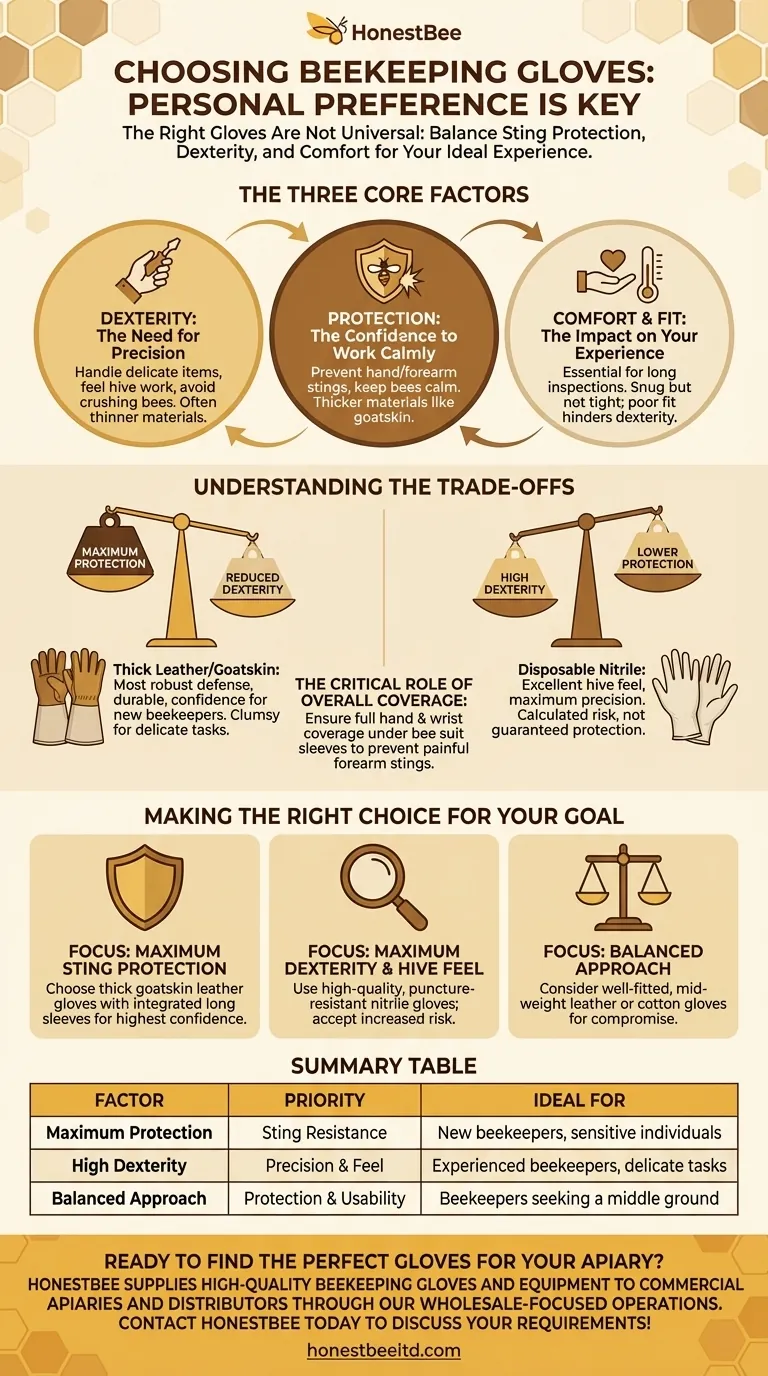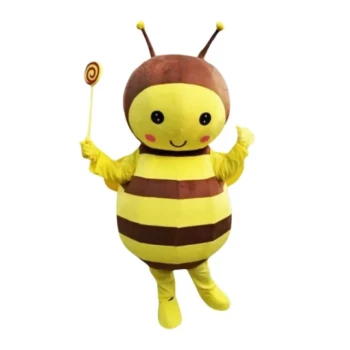The right beekeeping gloves are not universal. Personal preference is the most important factor because every beekeeper must decide their own ideal balance between sting protection, dexterity, and overall comfort. What feels safe and functional for one person may feel clumsy or inadequate for another.
Choosing beekeeping gloves is not about finding the single "best" pair, but about understanding the fundamental trade-offs between protection and precision. Your personal preference simply reflects the balance that gives you the confidence to work calmly and effectively.

The Three Core Factors of Glove Selection
Your choice of beekeeping gloves will always be a compromise between three competing needs. Understanding these factors is the key to making an informed decision that suits your personal style.
Dexterity: The Need for Precision
Dexterity is your ability to handle delicate items with your fingers. When working a hive, you need to gently lift frames, handle a queen cage, or mark a queen without being clumsy.
Gloves that offer high dexterity allow you to feel what you're doing, reducing the risk of accidentally crushing bees or dropping equipment. This precision is often found in thinner materials.
Protection: The Confidence to Work Calmly
The primary purpose of gloves is to prevent stings on your hands and forearms. This protection allows you to work with a calm and steady demeanor, which is crucial for keeping the bees calm.
Thicker materials like goatskin leather offer the highest level of sting resistance. Many gloves also feature long sleeves with elastic cuffs to ensure bees cannot crawl inside.
Comfort and Fit: The Impact on Your Experience
Comfort is about more than just how the material feels. It’s about how the gloves perform during a long inspection on a hot day.
A proper fit is essential. Gloves should be snug but not tight, with no excess material at the fingertips. A poor fit can hinder your dexterity just as much as a thick material and can even lead to you accidentally harming your bees.
Understanding the Trade-offs
No single glove excels in all areas. The material you choose will inherently prioritize one factor over another. This is where your personal judgment becomes critical.
Maximum Protection vs. Reduced Dexterity
Traditional leather and goatskin gloves provide the most robust defense against stings. They are thick, durable, and give new beekeepers immense confidence.
However, this thickness comes at the cost of dexterity. It can be difficult to perform delicate tasks, making these gloves feel clumsy to some experienced beekeepers.
High Dexterity vs. Lower Protection
Many beekeepers opt for disposable nitrile exam gloves. They offer an excellent feel for the hive, allowing for maximum precision and control.
While nitrile gloves are surprisingly puncture-resistant, they do not offer the same level of guaranteed protection as thick leather. They are a calculated risk taken in exchange for better dexterity.
The Critical Role of Overall Coverage
Regardless of the primary material, ensure your gloves provide full coverage of your hands and wrists. They should be worn under the sleeve of your bee suit or jacket.
This overlap prevents bees from gaining access to the skin on your forearms, a common and painful place to be stung.
Making the Right Choice for Your Goal
Your ideal glove depends entirely on what you want to achieve and your comfort level with your bees.
- If your primary focus is maximum sting protection: Choose thick goatskin leather gloves with integrated long sleeves for the highest level of confidence.
- If your primary focus is maximum dexterity and hive feel: Use high-quality, puncture-resistant nitrile gloves, but understand the increased risk of an occasional sting.
- If your primary focus is a balanced approach: Consider a well-fitted, mid-weight leather or cotton glove that offers a compromise between protection and usability.
Ultimately, the best beekeeping gloves are the ones that allow you to work with confidence, care, and control.
Summary Table:
| Factor | Priority | Ideal For |
|---|---|---|
| Maximum Protection | Sting Resistance | New beekeepers, sensitive individuals |
| High Dexterity | Precision & Feel | Experienced beekeepers, delicate tasks |
| Balanced Approach | Protection & Usability | Beekeepers seeking a middle ground |
Ready to find the perfect gloves for your apiary?
HONESTBEE supplies high-quality beekeeping gloves and equipment to commercial apiaries and distributors through our wholesale-focused operations. We offer a range of options to meet your specific needs for protection, dexterity, and comfort.
Contact HONESTBEE today to discuss your requirements and get the right gear for your beekeeping success!
Visual Guide

Related Products
- Beekeeping Gloves Goatskin Leather with Long Cotton Sleeve for Beekeepers
- Mesh Ventilated 3 Layer Goatskin Beekeepers Gloves for Beekeeping
- Goatskin Leather Beekeeper Gloves with Vent Long Sleeve for Beekeeping Honey Bee Sting Proof Protection
- Goat Skin Leather Bee Sting Proof Beekeeping Gloves with Canvas Sleeve
- Professional Drop-Style Hive Handles for Beekeeping
People Also Ask
- What is the difference between cleaning cow leather and goat leather beekeeping gloves? Tailor Your Care for Longevity
- What are the arguments for and against using gloves in beekeeping? Balancing Protection and Dexterity
- What is the safest way to handle frames in beekeeping? Master Gentle Handling for a Calm Hive
- Why are protective gloves important in beekeeping? Boost Confidence & Safety in Your Apiary
- What should beekeepers consider regarding the fit of beekeeping gloves? Achieve Safety and Dexterity



















